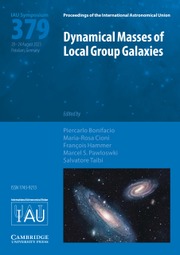No CrossRef data available.
Article contents
Mass models of disk galaxies from gas dynamics
Published online by Cambridge University Press: 30 October 2025
Abstract
I review methods and techniques to build mass models of disk galaxies from gas dynamics. I focus on two key steps: (1) the derivation of rotation curves using 3D emission-line datacubes from H I, CO, and/or Hαobservations, and (2) the calculation of the gravitational field from near-infrared images and emission-line maps, tracing the stellar and gas mass distributions, respectively. Mass models of nearby galaxies led to the establishment of the radial acceleration relation (RAR): the observed centripetal acceleration from rotation curves closely correlates with that predicted from the baryonic distribution at each galaxy radius, even when dark matter supposedly dominates the gravitational field. I conclude by discussing the (uncertain) location of Local Group dwarf spheroidal galaxies on the RAR defined by more massive disk galaxies.
Information
- Type
- Contributed Paper
- Information
- Proceedings of the International Astronomical Union , Volume 19 , Symposium S379: Dynamical Masses of Local Group Galaxies , December 2023 , pp. 335 - 346
- Creative Commons
- This is an Open Access article, distributed under the terms of the Creative Commons Attribution licence (https://creativecommons.org/licenses/by/4.0/), which permits unrestricted re-use, distribution and reproduction, provided the original article is properly cited.
- Copyright
- © The Author(s), 2025. Published by Cambridge University Press on behalf of International Astronomical Union


